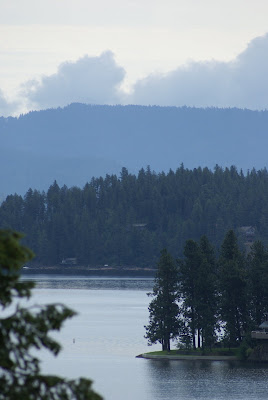Italy 2008 - Day 4 Palladian Villas - Asolo, Italy












Italy Day 4 was one of my favorites - the tour of two beautiful Andrea Palladio villas north of Venice, the famous Carlo Scarpa Brion Cemetery in San Vito d'Altivol, and finally a relaxing afternoon in Asolo, Italy.
We started at the Villa Emo. Villa Emo, located in the village of Fanzolo di Vedelago, was built in the period 1559-65. The central residential space features four columns (two of them engaged) in the manner of a Greek temple front. barchesse (farm buildings) The building extends symmetrically from the left and right of the central structure, with the ends of the barchesse surmounted by dovecotes. The result is the famous 5-part profile familiar in later Palladio-inspired architecture, including the U. S. Capitol building (with the Houses of Congress replacing the dovecotes!). This is a beautiful villa and like all of the Palladian villas I have seen they are picturesquely set and provide order and symmetry to the landscape. The frescos by Giovanni Battista Zelotti inside the central space are spectacular and are in excellent condition. We had a private guide, which in Italy is the best way to see any site or town, and she gave us a very detailed explanation of all the rooms, gardens and frescos. It is simply fascinating the time and attention to detail these architects and artisans put into these projects.
The next Palladian villa we toured was the Villa Barbaro located in the village of Maser adjacent to the famous hilltown of Asolo. The villa was built for Daniele Barbaro, Patriarch of Aquileia, and his brother Marc'antonio Barbaro, an ambassador of the Venetian Republic. Construction began in (prob.) 1549 and was substantially completed by 1558. The central residential space is erected on the remains of a medieval castle or manor house. Its facade features four engaged Ionic columns adapted from the Temple of Fortuna Virilis in Rome. As at nearby Villa Emo, barchesse (farm buildings) extend symmetrically from the left and right of the central structure. The ends of the barchesse are surmounted by dovecotes, each with a large sundial on the facade. The interior of the central residence is highlighted by magnificent frescos executed between 1560 and 1562 principally by Paolo Veronese. Set in the hillside at the rear of the central residence is a spectacular spring-fed statuary grotto known as a nymphaeum.
The villa first descended through female lines in the same family until 1838. In 1934 the villa was acquired by Giuseppe Volpi di Misurata, who began the restoration that has returned to villa to its present condition. Today his granddaughter resides at the villa with her family. As in most things in Italy the family lineage and passion for maintaining their history, architecture and culture are first and foremost. These homes are part of their soul not investments. They become great investments later only because of the love and passion for these works of art.
We then took a break and headed to our best lunch on the trip in the hill town of Asolo, Italy - Ristorante de Gerry. This is a wonderful place up on a second floor with great views of the surrounding countryside from both the restaurant and the adjoining roof garden. We started with some fried mozzarella balls and sausage balls followed by a roast chicken salad and stuffed and fried zucchini flowers then roast pork and rosemary roasted potatoes all capped off with a fabulous apple tart with a zabaglione sauce. Of course a few glasses of prosecco and some red wine with the roast pork all capped by a cappuccino make for a wonderful lunch.
We then ventured to the famous Carlos Scarpa Brion - Vega Cemetery in San Vito d'Altivole, Italy. With the Brion Cemetery, Scarpa made his impact with an unreserved commitment ot the modern movement and a new sureness of language. He re-created here the splendor of nineteenth-century Middle Europe, where beauty had the power to redeem man from his limitations. He avoided the narrow dictates of rationalism, choosing rather to stress inner depth, dreams, and nostalgia. Carlos Scarpa said about the Tomb, "The place for the dead is a garden....I wanted to show some ways in which you could approach death in a social and civic way; and further what meaning there was in death, in the ephemerality of life—other than these shoe-boxes." Even if you do not appreciate or enjoy contemporary architecture this is a very unique and definitely spiritual space.
We next boarded the bus back for the village of Asolo in the foothills of the Alps. Known as the "Town of a Hundred Horizons" because of its panoramic views, this nub of a medieval hill town (though it was founded during the twilight of Imperial Rome) has become the secret hideaway for true Veneto aficionados. After walking through town we ventured to one of Heather and my favorite spots the famous Hotel Villa Cipriani in Asolo. Immersed in a private garden of pomegranate trees and fragrant seasonal flowers, Hotel Villa Cipriani is surrounded by the views that inspired Titian and Giorgione. Once the home of the famous poet Robert Browning, the hotel offers guests 31 rooms splendidly fitted with lovely antiques and exposed ornated beams. Recent guest have included Kim Bassinger and Rolling Stones rocker, Keith Richards. There is nothing nicer than sitting on the terrace with a peach bellini and chatting with friends while watching the sun set over the hills. It is magical and most memorable.
The day ended at a local pizzeria - a crusty coal fired capricciosa pizza. It's usually the richest pizza offered, and every pizzaiolo makes it differently. This is based on the Pizzaria Giancarlo, outside Florence's Porta San Frediano and includes ham, artichoke hearts, mozzarella, and of course tomato sauce - then you add whatever else you have taking up space in the refrigerator. Add a cold Birra Moretti and you just had a great day in Italy.


Comments